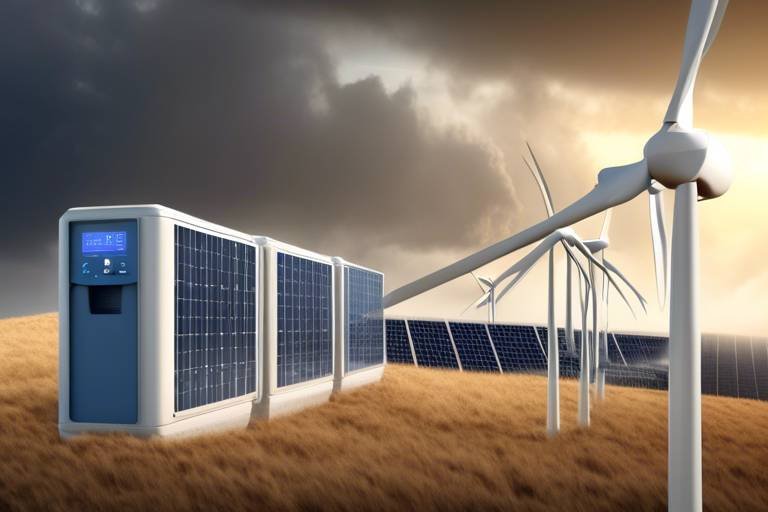How Smart Technologies are Improving Air Quality
In today's fast-paced world, the air we breathe is becoming increasingly polluted, and the consequences of this are alarming. Smart technologies are stepping up to tackle these issues head-on, providing innovative solutions that not only monitor but also actively improve air quality. Imagine a world where your smartphone can alert you to dangerous pollution levels in real-time or where city planners utilize data-driven insights to create cleaner urban environments. This is not just a dream; it is becoming a reality thanks to advancements in technology.
The integration of smart technologies into air quality management is revolutionizing how we approach environmental health. With the rise of the Internet of Things (IoT), we now have access to a plethora of devices that can measure air quality in real-time. These devices are transforming our understanding of pollution sources and trends, allowing for more effective decision-making. The implications for public health are profound, as improved air quality leads to fewer respiratory issues, reduced healthcare costs, and overall enhanced quality of life.
Furthermore, the accessibility of these technologies means that communities can take matters into their own hands. Low-cost sensors allow individuals and local organizations to monitor air quality, empowering them to advocate for cleaner air in their neighborhoods. This grassroots approach, coupled with data from larger municipal monitoring systems, creates a comprehensive picture of air quality that can drive policy changes and community initiatives.
In the following sections, we'll delve deeper into how smart technologies are being utilized in air quality monitoring, urban planning, and public engagement, illustrating the exciting possibilities that lie ahead. The journey to cleaner air is not just a technological challenge; it's a collective effort that involves every one of us. So, let's explore how we can harness these innovations to breathe easier and live healthier lives.
- What are smart technologies? Smart technologies refer to devices and systems that use advanced sensors, data analytics, and connectivity to monitor and improve various aspects of our lives, including air quality.
- How do IoT devices help in air quality monitoring? IoT devices collect real-time data on air pollutants, enabling better understanding and management of air quality issues.
- Can low-cost sensors be reliable? Yes, while they may have some limitations, low-cost sensors can provide valuable insights and empower communities to take action.
- How can I contribute to improving air quality? You can participate by using mobile apps to monitor air quality, advocating for cleaner practices in your community, and supporting local initiatives aimed at reducing pollution.

Understanding Air Quality Issues
Air quality is a pressing concern that affects millions of people around the globe. With urbanization on the rise, cities are becoming hubs of activity but also sources of pollution. The primary culprits of air pollution include vehicle emissions, industrial discharges, and even natural phenomena like wildfires. These pollutants not only degrade the quality of the air we breathe but also pose serious health risks. For instance, particulate matter (PM), nitrogen dioxide (NO2), and sulfur dioxide (SO2) have been linked to respiratory diseases, cardiovascular problems, and even premature death. It’s alarming to think that something as essential as air can become a silent killer, isn’t it?
Moreover, the impact of poor air quality extends beyond individual health. It affects entire communities, leading to increased healthcare costs and reduced quality of life. Children, the elderly, and those with pre-existing health conditions are particularly vulnerable. As we delve deeper into understanding air quality issues, we must recognize that effective solutions are not just necessary; they are urgent.
One of the challenges we face in tackling air quality issues is the lack of real-time data. Traditionally, air quality monitoring has relied on a few stationary monitoring stations that may not accurately reflect conditions in more localized areas. This can lead to a significant gap in understanding the true state of air quality, making it difficult for policymakers and the public to take informed action. As we look for innovative solutions, it becomes clear that we need to harness technology to bridge this gap.
Additionally, it's crucial to consider the economic implications of air pollution. According to the World Health Organization (WHO), air pollution costs the global economy an estimated $5 trillion annually in welfare costs. This staggering figure underscores the importance of investing in cleaner technologies and sustainable practices. We cannot afford to ignore the economic burden of poor air quality, especially when innovative solutions are at our fingertips.
In summary, understanding air quality issues is not just about recognizing the sources of pollution; it’s about grasping the broader implications for health, community well-being, and the economy. As we explore smart technologies that can help improve air quality, we must keep these challenges in mind. The journey towards cleaner air is not just a technical challenge; it’s a societal imperative.

Role of IoT in Air Quality Monitoring
The advent of Internet of Things (IoT) technology has revolutionized the way we monitor and manage air quality. Imagine a world where tiny devices scattered throughout our cities can continuously measure pollution levels and provide real-time data to everyone. This is no longer a futuristic dream; it's a reality that is shaping our understanding of air quality issues. With the rise of IoT, we are now equipped with tools that allow us to gather invaluable insights into the air we breathe, enabling more informed decisions for public health and environmental protection.
IoT devices, such as smart sensors, are at the forefront of this transformation. These devices can detect various pollutants, including particulate matter (PM), nitrogen dioxide (NO2), and ozone (O3), which are notorious for their harmful effects on health. By deploying these sensors in strategic locations, cities can create a comprehensive air quality monitoring network. For instance, a city might use sensors in parks, schools, and busy intersections to gather data that reflects the diverse air quality scenarios faced by its residents.
One of the most significant advantages of IoT in air quality monitoring is the ability to collect data in real-time. This means that stakeholders, including government agencies, environmental organizations, and even the general public, can access up-to-date information about air quality conditions. For example, when pollution spikes due to traffic congestion or industrial emissions, alerts can be sent out to inform residents, allowing them to take precautionary measures. This proactive approach not only enhances public safety but also encourages community engagement in air quality initiatives.
Additionally, the data collected by these IoT devices can be analyzed to identify trends over time. This is crucial for understanding the long-term effects of pollution and for developing effective strategies to combat it. For instance, if data shows that air quality worsens during certain times of the year, policymakers can implement measures such as promoting public transport or introducing stricter emissions regulations during those periods. The ability to visualize this data through interactive dashboards further empowers stakeholders to make informed decisions.
Moreover, the integration of IoT with mobile applications has made air quality information even more accessible. Users can download apps that connect to these smart sensors, providing them with real-time updates on air quality in their vicinity. Features of these apps often include:
- Alerts: Notifications when air quality reaches unhealthy levels.
- Historical Data: Access to past air quality trends for better understanding.
- Health Recommendations: Tips on how to minimize exposure based on current conditions.
This level of accessibility not only boosts public awareness but also fosters a sense of responsibility among citizens. When people are informed about the air quality they are exposed to, they are more likely to advocate for changes that can lead to cleaner air. Furthermore, community-driven initiatives, such as local clean-up events or tree-planting days, can be organized based on the data provided by these IoT devices.
In conclusion, the role of IoT in air quality monitoring is pivotal. By harnessing the power of technology, we can create a healthier environment for ourselves and future generations. As cities continue to grow and pollution levels rise, the need for innovative solutions has never been more critical. Embracing IoT not only enhances our understanding of air quality but also empowers communities to take action, ensuring that clean air becomes a priority for all.
Q1: What types of pollutants can IoT sensors detect?
A1: IoT sensors can detect various pollutants, including particulate matter (PM), nitrogen dioxide (NO2), sulfur dioxide (SO2), and ozone (O3), among others.
Q2: How can I access real-time air quality data?
A2: You can access real-time air quality data through mobile applications that connect to IoT sensors deployed in your area. These apps provide updates and alerts based on current conditions.
Q3: Are low-cost sensors accurate?
A3: While low-cost sensors may not be as precise as high-end models, they provide valuable insights and trends that can be beneficial for community monitoring and awareness.
Q4: How can communities use IoT data to improve air quality?
A4: Communities can use IoT data to advocate for policy changes, organize local initiatives, and increase public awareness about air quality issues, ultimately driving collective action for cleaner air.

Smart Sensors and Their Applications
Smart sensors are revolutionizing the way we monitor and manage air quality. These innovative devices are designed to detect various pollutants in the air, providing real-time data that is crucial for understanding environmental conditions. Imagine walking through a city where you can instantly know the air quality around you—this is the power of smart sensors. They are not just tools; they are our allies in the fight against pollution.
One of the key applications of smart sensors is their ability to measure a wide range of air pollutants, including particulate matter (PM2.5 and PM10), nitrogen dioxide (NO2), and ozone (O3). By capturing this data, cities can identify pollution hotspots and take targeted actions to mitigate these issues. For instance, if a sensor detects high levels of PM2.5 in a particular area, city officials can investigate the source and implement measures such as traffic restrictions or increased green spaces.
Moreover, smart sensors are often equipped with advanced features such as GPS tracking and data logging. This allows them to not only measure air quality but also to map pollution trends over time. The data collected can be visualized in various formats, making it easier for stakeholders to understand and act upon. For example, a city might use this data to create a pollution map that highlights areas in need of immediate attention.
In addition to their environmental benefits, smart sensors also play a significant role in public health. By providing real-time air quality information, they empower individuals to make informed decisions about their health. For instance, a person with asthma can check local air quality levels through a mobile app linked to these sensors, allowing them to avoid outdoor activities during high pollution days. This level of personal empowerment is a game-changer, fostering a community that is more aware and proactive about air quality issues.
Here's a quick overview of the types of smart sensors commonly used in air quality monitoring:
| Sensor Type | Pollutants Detected | Typical Applications |
|---|---|---|
| Low-Cost Sensors | PM2.5, PM10, CO, NO2 | Community monitoring, personal air quality tracking |
| Industrial Sensors | SO2, VOCs, O3 | Regulatory compliance, workplace safety |
| Mobile Sensors | Multi-pollutant detection | Mobile monitoring, research studies |
As the technology continues to evolve, we can expect even more sophisticated applications of smart sensors. For example, integrating artificial intelligence with sensor data can lead to predictive analytics, helping cities forecast pollution levels and prepare accordingly. This proactive approach can significantly enhance public health outcomes and contribute to a cleaner environment.
In conclusion, smart sensors are not just a technological advancement; they are a vital part of our strategy for improving air quality. By providing accurate, real-time data, these sensors empower individuals and communities to take action, ultimately leading to healthier urban environments. As we continue to embrace these technologies, the future looks brighter—quite literally—for our air quality.

Low-Cost Sensor Technologies
The advent of has revolutionized the way we monitor air quality, making it more accessible than ever before. These sensors, often small and portable, provide a feasible solution for communities that previously lacked the resources to conduct extensive air quality assessments. Imagine being able to measure the air you breathe without breaking the bank—this is the promise of low-cost sensors.
One of the most significant advantages of these sensors is their affordability. Unlike traditional air quality monitoring stations, which can cost tens of thousands of dollars, low-cost sensors can be purchased for a fraction of that price, often ranging from $50 to $500. This price point allows schools, community organizations, and even individuals to invest in air quality monitoring, fostering a grassroots approach to environmental awareness.
However, it's essential to note that while low-cost sensors offer a cost-effective solution, they do have some limitations. For instance, their accuracy and calibration may not match that of high-end monitoring equipment. This discrepancy can lead to variations in data quality, which is why it's crucial for users to understand the capabilities and limitations of these devices. Many low-cost sensors may be excellent for tracking general trends but may struggle with precise measurements of specific pollutants.
Despite these challenges, low-cost sensors empower local initiatives in remarkable ways. They enable communities to collect data on air quality in real-time, fostering a sense of ownership and responsibility towards their environment. For example, a neighborhood group can deploy multiple sensors throughout their area, gathering data that reveals pollution hotspots. This localized data can then be used to advocate for cleaner air policies or to inform residents about when to limit outdoor activities due to poor air quality.
Moreover, these sensors often come equipped with connectivity features, allowing them to transmit data to cloud platforms for further analysis. This integration can be particularly beneficial when combined with mobile applications, which can display real-time air quality data in an easily digestible format. Users can receive alerts when pollution levels exceed safe thresholds, empowering them to make informed decisions about their health and well-being.
In conclusion, low-cost sensor technologies are not just tools; they are catalysts for change. They democratize air quality monitoring, enabling communities to take charge of their environmental health. As more individuals and organizations adopt these technologies, we can expect a broader movement towards cleaner air and healthier living conditions.
- What are low-cost air quality sensors?
Low-cost air quality sensors are affordable devices designed to measure various pollutants in the air, making air quality monitoring accessible to everyone. - How accurate are low-cost sensors?
While low-cost sensors provide valuable data, they may not be as accurate as high-end monitoring systems. It's important to understand their limitations. - Can I use low-cost sensors for community projects?
Absolutely! These sensors are perfect for community initiatives, allowing groups to monitor air quality and advocate for cleaner air. - Do low-cost sensors require maintenance?
Yes, like any monitoring equipment, low-cost sensors may require occasional calibration and maintenance to ensure accurate readings.

Integration with Mobile Apps
In today's fast-paced world, staying informed about air quality is more crucial than ever. Thanks to the integration of smart sensors with mobile applications, individuals can now access real-time air quality data right at their fingertips. Imagine walking down the street and receiving instant notifications about pollution levels that could affect your health. This is not just a futuristic dream; it's a reality made possible by innovative technologies.
Mobile apps designed to work with smart sensors are transforming how we monitor air quality. These apps provide users with a wealth of information, including current pollution levels, forecasts, and health recommendations. For instance, if you live in a city where smog is a common issue, these apps can alert you when air quality dips below safe levels, allowing you to take precautions. But how exactly do these apps enhance our understanding of air quality?
One of the standout features of these applications is their user-friendly interfaces, which make complex data easily digestible. Users can view air quality indices, understand the sources of pollutants, and even compare different areas within their city. This kind of accessibility empowers people to make informed choices about their daily activities. For example, if the app indicates high levels of particulate matter, users might decide to avoid outdoor exercise or wear masks when going out.
Moreover, many of these apps include social features that foster community engagement. Users can share their experiences and insights, creating a network of informed citizens who advocate for cleaner air. This collective action can lead to significant changes, as local governments often respond to public demand for better air quality measures. In essence, these apps act as a bridge between technology and community activism, making air quality a shared responsibility.
Furthermore, some apps offer personalized health recommendations based on individual sensitivities and local air quality data. For instance, if you have asthma, the app can alert you to potential triggers and suggest alternative routes for your daily commute. This level of personalization helps individuals take control of their health in ways that were previously unimaginable.
To illustrate the impact of these mobile applications, here’s a quick comparison of some popular air quality apps:
| App Name | Key Features | Platforms |
|---|---|---|
| AirVisual | Real-time data, global coverage, health recommendations | iOS, Android |
| Plume Labs | Personalized alerts, pollution forecasts, community features | iOS, Android |
| Air Quality Index (AQICN) | Global air quality index, historical data, educational resources | Web, iOS, Android |
In conclusion, the integration of mobile apps with smart sensors is a game-changer in the realm of air quality monitoring. By making data accessible and actionable, these technologies empower individuals to take charge of their health and advocate for cleaner air. As we continue to embrace these innovations, we can look forward to a future where everyone has the tools they need to breathe easier and live healthier lives.
- What are smart sensors? Smart sensors are devices that measure environmental data, such as air quality, and transmit this information to mobile applications for real-time monitoring.
- How can mobile apps help in air quality management? Mobile apps provide users with real-time data, health recommendations, and community engagement features, allowing for informed decision-making and collective action.
- Are there any costs associated with using air quality apps? Most air quality apps are free to download, although some may offer premium features for a fee.
- Can these apps predict future air quality? Yes, many apps provide forecasts based on historical data and current pollution levels, helping users plan their activities accordingly.

Data Analysis and Visualization Techniques
When it comes to tackling air quality issues, the phrase "data is power" couldn't be more accurate. Data analysis and visualization techniques are the backbone of understanding the complex web of air pollution sources, trends, and impacts. Imagine trying to navigate a dense forest without a map; that’s how challenging it can be to address air quality without proper data analysis. By leveraging advanced analytical tools and visualization methods, stakeholders can make informed decisions that lead to cleaner air.
One of the primary methods employed in data analysis is statistical modeling. This technique allows researchers to identify patterns and correlations within air quality data. For instance, by analyzing historical pollution data alongside meteorological conditions, scientists can predict pollution spikes and develop strategies to mitigate them. Furthermore, predictive modeling can help city planners anticipate the impact of new construction or traffic changes on air quality. The ability to forecast these trends is akin to having a crystal ball for urban health.
Visualization techniques, on the other hand, serve as the visual storytellers of air quality data. Tools like heat maps, line graphs, and interactive dashboards transform raw data into easily digestible formats. For example, a heat map can vividly illustrate areas of high pollution, allowing residents to see the air quality in their neighborhoods at a glance. This not only raises awareness but also empowers communities to advocate for cleaner air. Using tools like Tableau or Power BI, organizations can create dynamic visualizations that update in real-time, providing ongoing insights into air quality conditions.
To illustrate the effectiveness of these techniques, consider the following table, which summarizes various data analysis methods and their applications in air quality management:
| Data Analysis Method | Application |
|---|---|
| Statistical Modeling | Identifying pollution trends and forecasting future air quality |
| Machine Learning | Predictive analytics to determine pollution sources and impacts |
| Geospatial Analysis | Mapping pollution hotspots and correlating with demographic data |
| Time-Series Analysis | Monitoring changes in air quality over time |
Moreover, the integration of machine learning into air quality analysis is revolutionizing how we interpret data. By training algorithms to recognize patterns in large datasets, we can uncover hidden relationships that traditional methods might miss. This technology can predict the impact of various factors on air quality, such as traffic patterns or industrial emissions, allowing for proactive measures rather than reactive ones.
Lastly, it’s important to highlight the role of community engagement in data visualization. By making air quality data accessible and easy to understand, we can foster a sense of ownership among residents. Educational workshops that teach individuals how to interpret air quality data can empower them to take action, whether it's advocating for policy changes or adopting greener practices in their daily lives. After all, when people understand the stakes, they are far more likely to participate in solutions.
- What are the main sources of air pollution?
Common sources include vehicle emissions, industrial discharges, and natural phenomena such as wildfires. - How can individuals contribute to improving air quality?
Simple actions like reducing car travel, using public transport, and supporting local green initiatives can make a significant impact. - What role does government play in air quality management?
Governments can implement regulations, monitor air quality, and promote public awareness campaigns to improve air standards.

Smart Technologies in Urban Planning
Urban planning is undergoing a revolutionary transformation, thanks to the integration of smart technologies. These advancements not only enhance the efficiency of city management but also prioritize air quality as a core component of sustainable urban development. Imagine a city where pollution levels are monitored in real-time, allowing planners to make informed decisions that directly improve the air we breathe. This is not just a dream; it is becoming a reality as cities worldwide adopt innovative solutions to tackle air quality issues.
One of the most exciting aspects of smart technologies in urban planning is the ability to create sustainable cities. By incorporating data from various sources, including air quality sensors and public feedback, urban planners can design environments that are not only livable but also healthy. For instance, cities can implement green spaces strategically, ensuring that parks and urban forests are located in areas with the highest pollution levels. This approach not only beautifies the city but also acts as a natural filter for airborne pollutants.
Furthermore, the use of geographic information systems (GIS) allows planners to visualize air pollution hotspots and assess the effectiveness of different interventions. By analyzing this data, they can prioritize areas that require immediate attention, ensuring that resources are allocated efficiently. For example, a city might discover that specific neighborhoods suffer from higher levels of particulate matter and can then focus on enhancing green infrastructure in those areas.
In addition to improving air quality, smart technologies foster community engagement. Engaging the public in urban planning processes is crucial for creating a sense of ownership and responsibility. Through mobile applications, residents can report air quality concerns, access real-time data, and participate in public forums. This interaction not only raises awareness but also encourages collective action towards improving local air quality. Imagine a community where residents actively collaborate with urban planners to create cleaner, healthier spaces for everyone!
Moreover, the integration of smart traffic management systems can significantly reduce vehicular emissions, a major contributor to urban air pollution. By optimizing traffic flow and promoting the use of public transportation, cities can decrease congestion and, consequently, lower pollution levels. For instance, smart traffic signals can adjust their timing based on real-time traffic conditions, ensuring a smoother flow of vehicles and reduced idling times.
As we look to the future, it is clear that smart technologies are not just a trend—they are essential for effective urban planning. By prioritizing air quality and leveraging data-driven insights, cities can transform into healthier, more sustainable environments. The challenge lies in ensuring that these technologies are accessible and equitable, allowing all communities to benefit from cleaner air and a better quality of life.
- What are smart technologies in urban planning? Smart technologies refer to digital tools and systems that enhance the efficiency and sustainability of urban environments, including IoT devices, GIS, and smart traffic management systems.
- How do smart technologies improve air quality? They provide real-time data on pollution levels, help in planning green spaces, and optimize traffic flow to reduce emissions, ultimately leading to cleaner air.
- Can residents participate in urban planning? Yes, many cities now use mobile apps and online platforms to engage residents in the planning process, allowing them to report issues and provide feedback.
- What is the role of green infrastructure? Green infrastructure, such as parks and urban forests, plays a crucial role in filtering pollutants and improving overall air quality in urban areas.

Green Infrastructure and Smart Solutions
In the quest for cleaner air, green infrastructure has emerged as a beacon of hope, seamlessly integrating nature with urban environments. Imagine a city where parks, green roofs, and urban forests not only beautify the landscape but also actively filter pollutants from the air. This is not just a dream; it's a reality being shaped by innovative solutions that harness the power of nature to combat air quality issues. By incorporating green elements into urban planning, cities can significantly reduce their carbon footprint while improving the overall well-being of their inhabitants.
One of the most exciting aspects of green infrastructure is its ability to work hand-in-hand with smart technologies. For instance, consider the implementation of smart sensors in urban parks that monitor air quality in real-time. These sensors can detect levels of pollutants and provide data that informs city planners about the effectiveness of green spaces in improving air quality. When combined with data analytics, this information can lead to targeted interventions, such as planting more trees in areas with high pollution levels.
Let's take a closer look at some of the successful implementations of green infrastructure:
| Project Name | Location | Features | Impact on Air Quality |
|---|---|---|---|
| High Line | New York City, USA | Elevated park with native plants | Reduced local air pollutants by 10% |
| Green Roofs | Various Cities | Vegetated rooftops on commercial buildings | Improved insulation and air filtration |
| Urban Forests | Melbourne, Australia | Extensive tree planting initiatives | Enhanced air quality and biodiversity |
These projects exemplify how integrating nature into urban spaces can lead to substantial improvements in air quality. However, it’s not just about planting trees or creating parks. The design and maintenance of these green infrastructures are crucial. For example, the selection of plant species plays a vital role in their ability to absorb pollutants. Native plants are often preferred because they are better adapted to local conditions and require less maintenance.
Moreover, community involvement in these initiatives cannot be overstated. Engaging local residents in planting and maintaining green spaces fosters a sense of ownership and responsibility towards the environment. When communities are educated about the benefits of green infrastructure, they are more likely to support and participate in these initiatives, leading to a collective effort towards cleaner air.
As cities continue to grow, the challenges of air pollution will only intensify. However, by embracing green infrastructure and smart solutions, urban areas can transform these challenges into opportunities for innovation and sustainability. The synergy between nature and technology not only enhances air quality but also enriches the urban experience, making cities healthier and more livable for everyone.
- What is green infrastructure?
Green infrastructure refers to a network of natural and semi-natural features in urban areas that provide environmental benefits, such as improved air quality, stormwater management, and biodiversity. - How do smart technologies contribute to air quality improvement?
Smart technologies, such as IoT sensors, collect real-time data on air quality, enabling city planners to make informed decisions and implement effective strategies for pollution reduction. - Can community involvement really make a difference?
Absolutely! Engaging the community in green initiatives fosters a sense of ownership and responsibility, leading to greater support and participation in maintaining healthier urban environments.

Public Engagement and Education
Public engagement and education play a critical role in addressing air quality issues. It's not just about having the technology; it's about making sure people understand how it impacts their lives. Imagine living in a city where the air quality is consistently poor. Wouldn't you want to know what you can do to improve it? This is where the power of education comes into play. By informing communities about the sources of pollution and its effects on health, we can foster a sense of responsibility and action among individuals.
One of the most effective ways to engage the public is through community workshops and informational sessions. These gatherings can provide residents with the tools they need to monitor air quality in their neighborhoods. For example, local governments can partner with schools and community organizations to host events that teach people how to use smart sensors and interpret their data. This hands-on approach not only educates but also empowers individuals to take charge of their environment.
Moreover, leveraging digital platforms can significantly enhance public engagement. Social media campaigns, mobile apps, and interactive websites can be utilized to disseminate information quickly and effectively. Imagine receiving real-time alerts on your phone about air quality changes in your area. This kind of immediate feedback can motivate residents to change their behavior, such as reducing outdoor activities on high pollution days or advocating for cleaner transportation options.
In addition to workshops and digital engagement, educational programs in schools can cultivate a new generation of environmentally conscious citizens. Schools can incorporate air quality topics into their science curricula, encouraging students to explore the impact of pollution on health and the environment. By involving students in projects that monitor air quality using smart technologies, we can instill a sense of stewardship for their communities from a young age.
Furthermore, public art projects and community initiatives can serve as creative ways to raise awareness about air quality. Murals or installations that illustrate the effects of pollution can spark conversations and encourage community members to take action. For instance, a local artist could create a piece that visually represents the air quality data collected by smart sensors, making the invisible visible and prompting discussions about what can be done to improve it.
Ultimately, fostering public engagement and education around air quality issues is about creating a culture of awareness and action. When people understand the implications of poor air quality, they are more likely to participate in initiatives aimed at improving it. Whether through workshops, digital platforms, or school programs, the goal is to empower communities to take ownership of their air quality challenges. Together, we can create a healthier, cleaner environment for everyone.
- What are the main sources of air pollution? Common sources include vehicle emissions, industrial discharges, and household products.
- How can I monitor air quality in my area? You can use smart sensors or mobile apps that provide real-time air quality data.
- Why is public engagement important for air quality? Engaging the public helps raise awareness, encourages community action, and fosters a sense of responsibility towards air quality issues.
- What role do schools play in air quality education? Schools can educate students about air quality and involve them in monitoring projects, promoting environmental stewardship from a young age.
Frequently Asked Questions
- What are the main sources of air pollution?
Air pollution comes from various sources, including vehicle emissions, industrial discharges, agricultural activities, and natural causes like wildfires. Understanding these sources is crucial for developing effective strategies to improve air quality.
- How do smart technologies help monitor air quality?
Smart technologies, particularly IoT devices, enable real-time monitoring of air quality. They gather data on pollutants and environmental conditions, providing valuable insights that help communities and authorities make informed decisions to combat pollution.
- What are low-cost air quality sensors?
Low-cost air quality sensors are affordable devices that measure pollutants in the air. They empower communities to monitor their local air quality, raising awareness and encouraging action towards cleaner air.
- Can I access real-time air quality data through mobile apps?
Absolutely! Many mobile applications integrate with smart sensors to provide users with real-time air quality data. These apps often include features like alerts for poor air quality, helping users stay informed and take necessary precautions.
- How does data analysis improve air quality management?
Data analysis plays a crucial role in understanding pollution trends and patterns. By visualizing this data, stakeholders can identify problem areas and develop targeted strategies to improve air quality effectively.
- What is green infrastructure?
Green infrastructure refers to natural and semi-natural systems that provide environmental benefits, such as green roofs, urban forests, and parks. These solutions not only enhance urban aesthetics but also improve air quality by filtering pollutants and increasing vegetation.
- How can the public get involved in air quality initiatives?
Public engagement is key to improving air quality. Communities can participate in educational programs, volunteer for local clean-up efforts, and advocate for policies that promote sustainable practices. Collective action can lead to significant improvements in air quality.



















